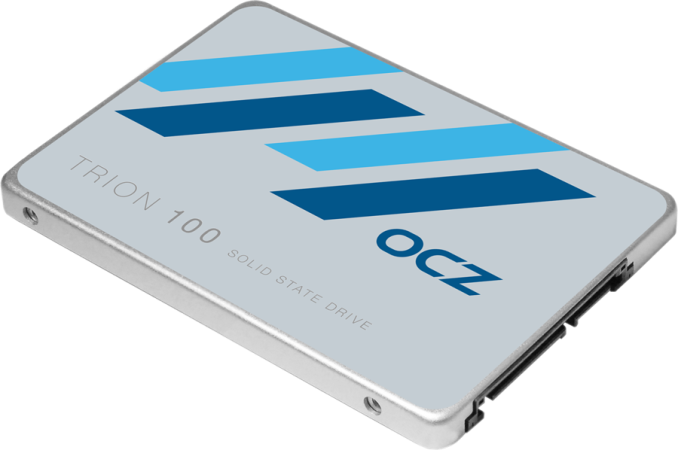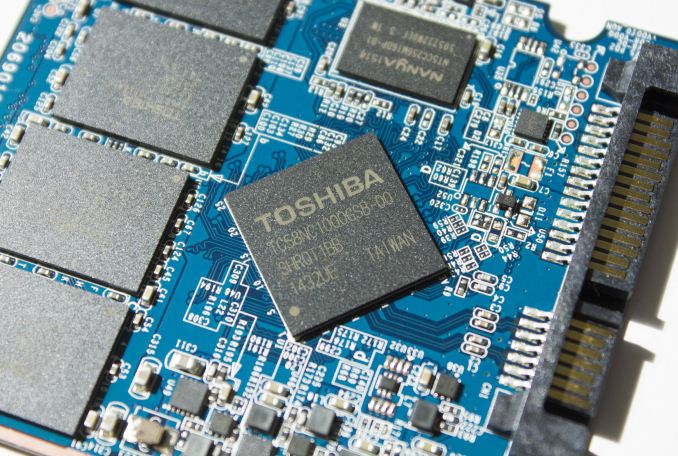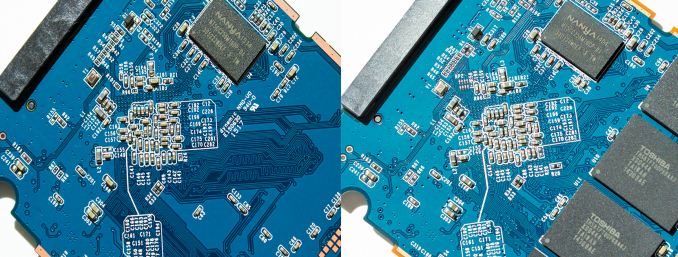OCZ Trion 100 (240GB, 480GB & 960GB) SSD Review: Bringing Toshiba to the Retail
by Kristian Vättö on July 9, 2015 12:01 PM EST
It's been a year and a half since OCZ went bankrupt and Toshiba acquired its assets. In this time we have seen OCZ transition all of its products to Toshiba NAND and we have also discussed how Toshiba has helped OCZ with its quality/validation processes, but quite frankly we haven't seen anything truly concrete coming out of the partnership. The Trion 100 is here to change that as it's the first Toshiba built drive that will retail under OCZ's brand.
The Trion 100 is a significant signal of the companies' strategy moving forward. While Toshiba is letting OCZ run its business independently, the two work closely together on new products and roadmaps to maximize resources and avoid overlaps. For TLC the companies decided to utilize Toshiba's IP because it had been developing a TLC SSD for years and was simply much longer in the process compared to OCZ. The Barefoot 3 doesn't have proper TLC support, so OCZ would have needed to either design a new controller or use a third party one, which isn’t as economical as using an in-house design.
OCZ wasn't involved in the development of the Trion 100, but it did help Toshiba to validate the drive. Basically, Toshiba approached OCZ in Design Verification Test (see our fab tour article for details) phase when it already had working samples and OCZ provided Toshiba with general feedback and suggestions for bug fixes through its own internal testing. None of OCZ's firmware engineers were involved in the Trion 100 project, though, as the design and development were executed solely by Toshiba. Manufacturing and run-in testing is also handled by Toshiba, so in all honesty the Trion 100 is a Toshiba drive that retails under OCZ as Toshiba doesn’t directly engage in the retail market.
Since Toshiba only does OEM sales, it isn't used to discussing its technology in detail, especially with media and the public. In the OEM market it's fine to sell a "black box" and only disclose the necessary specs (like performance and endurance) in a data sheet because ultimately the OEM customers are buying a solution with the underlying technology being a secondary interest (I would argue that most PC OEMs don't even fully understand the technology).
960GB Trion 100 on the left, 960GB Corsair Neutron XT on the right
As a result, the technical details of the drive are very scarce. The TC58 controller is supposedly made by Toshiba and so is the firmware, but Toshiba isn't willing to disclose any specifics of the architecture. However, I discovered that the PCB layout closely resembles the Phison S10, and the relation is substantial enough that I doubt it's a coincidence. There are only minor differences in resistor and capacitor placements, but when focusing on the area under the controller the two are undoubtedly a match. The timing is another clue because at Computex Phison told me that the company is a week or two away from finalizing the TLC firmware for the S10 and now a few weeks later Toshiba puts out its first TLC drive with nearly identical look to Phison S10 drives.
Officially Toshiba and OCZ are saying it’s a Toshiba controller, although OCZ is aware of the resemblance, but obviously the company can’t differ from Toshiba’s word. I did let OCZ know about my concerns regarding another rebrand (the Indilinx Everest controller turned out to be a Marvell silicon after all) and what it may do to the recovering OCZ brand, but OCZ’s hands are tied because the Trion 100 is fundamentally a Toshiba drive. OCZ has always been quite open about its technologies (Barefoot 3 for example), but as Toshiba has been doing business in a certain way for many years it will take time for the two to adapt. In the end, the Trion 100 has significant educational value to the Toshiba-OCZ organization because this is the first time that a Toshiba drive is specifically marketed for the retail market.
Toshiba and Phison have a very close relationship, so a co-developed controller is hardly a surprise, especially since Toshiba has done it before with Marvell and JMicron. Toshiba is one of the few companies that have (limited) access to Phison's firmware source codes and all Phison drives are manufactured in Toshiba's factories (Phison doesn't sell drives under its own brand, but it provides fully assembled drives to companies such as Corsair and Mushkin).
To me the biggest question is how customized the firmware is and how much it differs from the stock S10 firmware that Phison will be shipping to its own OEMs. I think it's safe to say that the silicon itself is the same because a separate die would be costly, but I suspect Toshiba has had a significant impact on the firmware. I don’t have any Phison S10 with TLC at hand at the moment, so we’ll have to wait a little longer before we can investigate how big of a difference Toshiba’s firmware makes.
| OCZ Trion 100 Specifications | ||||||
| Capacity | 120GB | 240GB | 480GB | 960GB | ||
| Controller | Toshiba TC58 | |||||
| NAND | Toshiba A19nm 128Gbit TLC | |||||
| Sequential Read | 550MB/s | 550MB/s | 550MB/s | 550MB/s | ||
| Sequential Write | 450MB/s | 520MB/s | 530MB/s | 530MB/s | ||
| 4KB Random Read | 79K IOPS | 90K IOPS | 90K IOPS | 90K IOPS | ||
| 4KB Random Write | 25K IOPS | 43K IOPS | 54K IOPS | 64K IOPS | ||
| Endurance | 30TB | 60TB | 120TB | 240TB | ||
| DevSleep Power | 6mW | |||||
| Idle Power | 830mW | |||||
| Max Power | 4.8W | |||||
| Encryption | N/A | |||||
| Warranty | Three years | |||||
| MSRP | $57 | $88 | $185 | $370 | ||
The TC58 doesn’t support LDPC error correction (and neither does the S10 for that matter), but utilizes Toshiba’s QSBC (Quadruple Swing-By Codes) ECC. Since Toshiba is tight lipped about any of its in-house technologies, the details surrounding QSBC are scarce, but I would speculate that it's something in-between BCH and LDPC error corrections. While LDPC offers higher error correction capability, it’s also slower as soft decoding is a time consuming process, so QSBC should provide better performance while still providing enough error correction capability to enable the use of TLC NAND.
| OCZ Trion 100 NAND Configurations | ||||
| Capacity | 120GB | 240GB | 480GB | 960GB |
| SLC Cache Size | 1.8GB | 3.6GB | 7.2GB | 14.4GB |
| Raw NAND Capacity | 128GiB | 256GiB | 512GiB | 1,024GiB |
| # of NAND Packages | 4 | 4 | 4 | 4 |
| # of Die per Package | 2x16GiB | 4x16GiB | 8x16GiB | 16x16GiB |
The Trion 100 uses pseudo-SLC cache to for improving write performance. The NAND is a specific SKU with pseudo-SLC capability (instead of simply writing to the lower pages), but unlike what SanDisk is doing in the Ultra II, Toshiba’s NAND doesn’t have a fixed SLC portion with different transistor characteristics. The size of the SLC cache is fixed, though, and it’s 1.5% of the total NAND capacity. That’s similar to what we have seen in other TLC drives and since client workloads are bursty by nature there isn’t really a need for more than a few gigabytes of SLC. There are some write optimizations done to reduce write amplification when writing from SLC to TLC, but again even OCZ isn’t aware of the specifics.
Despite the use of TLC NAND, the Trion 100 boasts excellent endurance. A part of that has to do with different validation workload because Toshiba uses JEDEC’s client workload to specify endurance, whereas OCZ provides worst-case figures based on a 4KB random write workload with substantially higher write amplification. This stems from the enterprise space where OCZ has been using 4KB random writes ever since the company started reporting endurance and in order to align with the enterprise numbers OCZ has decided to use the same workload for client drives as well, despite the fact that it’s arguably an overkill. OCZ is currently validating the rest of its drives with the JEDEC client spec and in the future we will likely see both figures, which I find to be a good strategy because it also gives us an insight to the write amplification.
The Trion uses Toshiba's A19nm 128Gbit TLC NAND, which is manufactured using the same underlying technology as the NAND used in SanDisk's Ultra II since the two companies have a NAND joint-venture. The most interesting aspect is that the 960GB model uses 16-die packages, which we haven't seen from Toshiba in a shipping product yet. Toshiba's NAND is actually packaged by a company called PTI, which is the same company that assembles SSDs for OCZ and a variety of other vendors.
| AnandTech 2015 SSD Test System | |
| CPU | Intel Core i7-4770K running at 3.5GHz (Turbo & EIST enabled, C-states disabled) |
| Motherboard | ASUS Z97 Deluxe (BIOS 2205) |
| Chipset | Intel Z97 |
| Chipset Drivers | Intel 10.0.24+ Intel RST 13.2.4.1000 |
| Memory | Corsair Vengeance DDR3-1866 2x8GB (9-10-9-27 2T) |
| Graphics | Intel HD Graphics 4600 |
| Graphics Drivers | 15.33.8.64.3345 |
| Desktop Resolution | 1920 x 1080 |
| OS | Windows 8.1 x64 |
- Thanks to Intel for the Core i7-4770K CPU
- Thanks to ASUS for the Z97 Deluxe motherboard
- Thanks to Corsair for the Vengeance 16GB DDR3-1866 DRAM kit, RM750 power supply, Hydro H60 CPU cooler and Carbide 330R case













65 Comments
View All Comments
valnar - Friday, July 10, 2015 - link
19nm process *and* TLC *and* a brand new ECC method? No thanks. Sounds too risky.NvidiaWins - Friday, July 10, 2015 - link
There's a reason OCZ went bankrupt....their SSD's are HORRIBLE!hojnikb - Saturday, July 11, 2015 - link
Good thing this is OCZ only by name.Read the d*** article.
ES_Revenge - Sunday, July 12, 2015 - link
Certainly a fail for OCZ/Toshiba. You'd think they would have "went back to the drawing board" with this instead of "releasing to the market". Ugh.But, OCZ does have some very good drives out there. Vector 150/180, Vertex 460/A, Radeon R7 drives are all very good (Vector with some impeccable services times and very fast at regular-people workloads), but in the SSD market competition is pretty stiff. If you can get one of the above OCZ drives at a good/sale price they can be excellent drives for the money. The ARC 100 was somewhat disappointing but not terrible so I don't see them as worth buying unless you're getting them at a really good price. The Trion though, not much else to say but fail.
Looks very much like this is a Phison-controlled drive and though Phison isn't bad it seems to require very specific NAND/configuration to actually shine. Either the TLC handling of the S10 is just poor or Toshiba's TLC isn't that great, or both/combination.
doggface - Monday, July 13, 2015 - link
The first manufacturer who can get a 128/256 GB ssd to be (within a few dollars of) the same price as a 5400rpm 500GB HDD -- Will win at life. Full stop. End of argument. All those rubbish midrange laptops that have everything a person needs except fast storage.... All they need is fast storage and they would be very capable and would catapult any OEM into a leading position in that demographic. If they can get this ssd down to those prices for OEM (I realise this is retail) then they have a winner. As an enthusiast drive... Massive fail.doggface - Monday, July 13, 2015 - link
Seriously, This is the perfect midrange laptop.13.3" display IPS
i5 or i3 (AMD equiv) or top cherrytrail.
4gb ram expandable.
128GB ssd
WiFi-n 5ghz.
Usb3/HDMI, camera etc
A decent keyboard
Clean looks.
If you can do that for $5-600 USD.
Millions of sales.
(U can do a better version with a FHD screen, faster WiFi/cpu/dGPU, bigger capacity SSD.)
Pessimism - Monday, July 13, 2015 - link
-Marketing from a dead brand with a bad reputation for reliability... Check!-Design from a stubborn, tight lipped old school Japanese megacorp who refuses to disclose technical details... Check!
-Controller sourced from a bottom-feeding Taiwanese manufacturer accustomed to designing barely functional solutions at minimal cost for OEMs... Check!
Recipe for a winner here!
LazloPanaflex - Tuesday, July 21, 2015 - link
LOL, well said!abufrejoval - Monday, July 13, 2015 - link
Clearly this drive wasn't designed for ultimate performance, but as I replace more and more of my HDDs with SSDs I begin to worry more about the reliability and endurance of the storage, than the performance:How sure can I be, that after five years of mixed usage, some intensive I/O, some stuff (e.g. baby pictures) only ever written once, the SSD perhaps lying around for two years in a safe or another having suffered through years in a quiet but rather warm passive PC every bit of data will come off exactly as it was written? Add automobile scenarios or others with lots of electronic noise to make things harder.
After all storage isn't just about pounding these things with random bits and see how long they last, it's about delivering on a promise to return everything as it was written a millisecond or years ago.
Anandtech can't really test that, even if they do an incredible job at testing what can be tested within such a short time and a limited budget.
But perhaps it's exactly in that area, the reliability under almost all circumstances, where Toshiba shines and others less so?
So far I never really worried, because my SSDs mostly contained cache data which was quickly forwarded to a RAID of trusted rotating rusties or had a backup copy on them: The overall risks and exposure times were low and seemed well managed with the tests done.
But as the rusties finally spin down and SSDs become the prime medium for all my data, perspective and requirements change.
For example the data decay discussion, where retention time depends and varies widely with write temperature and storage temperature.
If you retire an older SSD (as you might with HDDs) at 80% overwrite capacity used to become a backup device, write data with the drive barely warming beyond room temperature and then put it away in the cellar, dry and above freezing, and then plug it in a year or two later: Will you still get your data back?
Since the drive doesn't have a clock: How does it even know that it should start checking for and compensating bit rot?
What does that mean for your backup strategy: Should you fully rewrite the data every couple of months? Should pre-warm the drive before rewriting to ensure optimal retention?
I can't believe Toshiba was simply unable to design a product which was fast and economic. I'd like to believe that perhaps we are missing their design goal.
Easy to do, when they are keeping so quiet :-)
rocketman122 - Tuesday, July 14, 2015 - link
I wouldnt touch ocz if they gave it to me for free. such garbage and bad ethics as a company. didnt they file for bankruptcy? we dont need crap companies that make drives where people store important data on them. after selling the core series years back with the jmicron chips and knowing they were defective I have no respect for them. I tell anyone that asks about components NEVER to buy OCZ.